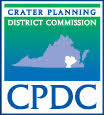Sussex County, Virginia was created by an act of the Virginia Legislature in 1754 when Sussex was taken from a part of the County of Surry. English settlement in Surry began approximately the same time that the headquarters of the Virginia Colony was fixed across the river at Jamestown in 1607.
Early History and Settlement
The Virginia Colony grew and spread out from its small beginning at Jamestown until in 1634, it was divided into eight original shires or counties. One of the eight was James City County which occupied both sides of the James River with its center of government at Jamestown.
Expansion of Colonial Virginia
The population of the colony continued to increase and in 1652, the part of James City County south of the James River was cut off and named Surry (without the “e”) for Surrey County, England.
By agreement with the Native Americans in the region, English settlement in the Surry area was not allowed beyond the Blackwater River until about 1700, almost one-hundred years after the first Virginians came to Surry.
How did Sussex County get its borders?
The land south of the Blackwater was settled rapidly and Sussex County was created from part of Surry County in 1754. There has been little change in the boundaries since that time. Sussex County is bounded on the north by the County of Prince George, northeast by the County of Surry and the Blackwater River, and on the south by the Counties of Greensville and Southampton and to the west by the County of Dinwiddie.
Who were the people who settled Sussex County in the beginning?
Virginian colonists, mostly originating from the British Empire, had settled in Sussex County since the 1600s however the Cheroenhaka (Nottoway) Indian Tribe and other Native Americans were already living in the area. In the United States Census of 1790, 10,549 persons were reported. Of that number, 54.8% were Africans approximately 10% of which were free in 1790 and 33% were free in 1860.
Sussex in the War for American Independence
Sussex played an active role in the achievement of American liberty. Colonel David Mason, who represented Sussex for years in the Virginia House of Burgesses in Williamsburg, was a member of the committee that drafted Virginia’s first state constitution in 1776, which incorporated the immortal Virginia Declaration of Rights.
Read More: Sussex in the American Revolution
Quakers and Emancipation in Sussex County
Concentrated around Seacock Swamp near the Wakefield area of the County, Quakers were at the forefront, along with the Methodists, in efforts to emancipate the slaves whom at the time formed the majority of the county's population.
Nearly four hundred slaves were freed in Sussex County by will or deed during the first three decades following 1776. One of these Quakers was John W. Watkins, County Surveyor from 1817 to 1830. He, like many of his neighbors, moved to Jefferson County. Ohio, along with their freed slaves, to live on free soil.
Michael Bailey, who was Clerk of the Sussex County Court from 1785 until his death in 1798, was one of the Quakers who freed his slaves. He was disavowed by the Quakers for not attending meetings and for serving as a public official.
Age of the Railway and the Four Towns in Sussex
In 1832 the nation’s first interstate railroad, the Petersburg and Weldon Railway (now CSX Railway), was built in the western part of Sussex, running through the Towns of Jarratt and Stony Creek.
In 1853 the lines of the Norfolk and Western Railway (now known as Norfolk Southern) were laid, connecting Hampton Roads with Petersburg and running through the Towns of Wakefield and Waverly.
These railroads put four towns in Sussex on the map as these communities began to grow by the establishments of Train Depots: Waverly, the oldest town in Sussex (chartered in 1879), Wakefield (incorporated in 1902), Stony Creek (incorporated in 1915), and Jarratt (chartered in 1938).
Why was General William Mahone so important to Sussex County?
General William Mahone, who built the Norfolk and Western Railway through Sussex, is memorialized by having U.S. Highway 460 (which runs parallel to the railroad through Sussex County) named in his honor.
His wife, Otelia, is remembered for naming the depots established along the way: Waverly for Sir Walter Scott’s series of romantic novels and Wakefield for Oliver Goldsmith’s Vicar of Wakefield.
Mahone, a native of Southampton County, was educated in Sussex at Littleton Academy, distinguished himself as a commander of the successful Confederate counterattack during the Battle of the Crater in 1864 and was the prominent political leader of the Readjuster Party in postwar Virginia.
Sussex County during the American Civil War
Sussex County was the scene of much military activity during the Civil War. Its local cavalry unit, the "Sussex Light Dragoons" borrowed their name from a preceding Revolutionary unit in the county. Its members became a part of the Thirteenth Virginia Cavalry.
In May of 1864, Jarratt’s Depot was destroyed by Union cavalryman, August Kautz, who demolished all buildings there except the tavern of Humphrey Grigg, which still survives.
Read More: Civil War and Reconstruction
Dawn of a New Era: Growing into the 20th Century
Sussex County saw the 19th Century as the same slow agrarian county it had always been, still largely dependent upon the horse for getting about. By the end of the 1800's the communities of Sussex County had ushered in changes which had swept the lifestyles and viewpoints of the county's citizens into a large mainstream with the rest of the state, the country, and the world.
Overcoming Adversity in the Early Twentieth Century
In the beginning of the 20th Century, segregation of the races was still accepted and unchallenged due to Jim Crow laws. Women did not vote. Each magisterial district had its own school board. The County Government had to take care of its own roads.
The Great Depression, which began in 1929 along with America's entrance into the Second World War (1941-1945), touched the county with the accompanying deprivations and sacrifices.
Justice Jesse Felix West
One of the prominent leaders of the county at the beginning of the century was Jesse Felix West of Waverly (died 1929), who had served as the last County Court Judge before becoming Judge of the Circuit Court and subsequently a Justice of the Supreme Court of Virginia's Court of Appeals. Judge West gave the keynote address at the dedication of the Monument of the Fallen Confederate Soldiers in 1913.
Sussex as a Political Powerhouse
Despite its small population, Sussex exhibited considerable political shrewdness in this century. From 1920 until 1991, with the exception of only a few years, Sussex was represented in the senate of Virginia by one of its own citizens: William B. Cocke of "Smithfield" near the Courthouse, 1920-1924; William O. Rogers of Waverly, 1924-1936; Garland Gray of Waverly, 1940-1945, 1948-1971; and Elmon T. Gray of Waverly, 1971-1991.
Senator Rogers (died 1951) served on the Senate Finance Committee and was instrumental in the construction of Route 460 through the county. After his tenure in the Senate, he served as county treasurer until his death.
Senator Garland Gray (1902-1977) became one of the most powerful and influential men in the Commonwealth. He is best remembered for his chairmanship of the commission called to deal with the problem of public school integration in 1954. He was in the "high command" of the Byrd Organization and was the leading Democratic candidate for governor in 1957, but he deferred to J. Lindsay Almond, Jr., in the interest of party unity. His son, Elmon T. Gray, succeeded him as senator, serving on the Senate Finance Committee.
Sussex's Fallen Heroes Remembered
Soldiers from Sussex County served their nation in every major war that the United States fought during the 20th Century.
Twenty of the county's young men were killed in the First World War (1914-1919), including handsome William Franklin Chappell, whose oratorical skills as a teenager had shown his great potential as a future leader in the county.
Twenty-five young men of Sussex County paid the ultimate price during the Second World War, two of them falling on the coast of Normandy on D-Day, June 6, 1944.
During the Cold War citizens of Sussex County also gave their lives in the Korean War and the Vietnam War.
Life in Sussex After World War II
As late as 1950 most automobiles did not travel long distances frequently. For most citizens, traveling to Richmond was a day trip and could only be afforded a few times a year. Most school children wore dungarees and tee shirts until the mid-1950s. Some mothers made dresses for their daughters out of flowered feed bags.
There were no Jones to keep up with but the disparity between the economic levels of the wealthy and those in poverty was very noticeable. Many poor people lived in shacks and did not have indoor plumbing.
Public Education and an End to Segregation
The 1960s saw the beginning of significant changes in the education system in Sussex County. Central High School near the Courthouse opened in 1960 as a replacement of the old Sussex County Training School in Waverly, which had been the county's lone black high school and had produced its first graduates in 1927.
Fifteen small black elementary schools west of the Nottoway River closed in March of 1961, with the opening of Central Elementary School. The new Ellen Warren Chambliss Elementary School at Wakefield, also initially a black school, opened in 1962. The new Annie B. Jackson Elementary School at Waverly opened in April 1965, and in the fall of 1965, a new Jefferson Elementary School opened at Jarratt.
The old white high schools at Wakefield and Jarratt, which had been producing high school graduates from 1910 and 1912, respectively, closed in 1964 to merge with Waverly and Stony Creek high schools. In 1964 the Tidewater Academy was established in Wakefield as a response to the consolidation and desegregation of the schools.
Waverly High School, which had its first graduating class in 1908, and Stony Creek High School, which saw its first graduates in 1912, were closed in 1970, when Sussex Central became the county's only high school. Although total integration of the entire county school system was accomplished that year, it was in the fall of 1965, with token integration at Stony Creek and Waverly high schools, that the public schools were actually integrated for the first time in the county's history.
Civil Rights and Race Equality in Sussex County
Inevitably, the structure of county life continued to change in the 1970s with the election of the first black members of the Board of Supervisors in 1975: Joseph F. Newsome of Courthouse District and Glover W. Pegram of Stony Creek District. Millard Stith, Sr., had been the first black appointed to the School Board in 1971.
In 1984, the Board of Supervisors gained its first black majority; in 1991, blacks constituted a majority on the School Board. The transition to a multiethnic government has been harmonious and one dedicated to the advancement and wellbeing of all of the citizens of Sussex County.
Historical Landmarks in Sussex County
There have been six landmarks in the county named to the Virginia Landmarks Register and the National Register of Historic Places.
The old courthouse (completed in 1828 by Dabney Cosby, who came to Sussex after completing the building of the University of Virginia under Jefferson), along with the 1817 and 1923 clerk's offices, the 1800 Dillard House and the 1810 Bannister House, collectively have been designated the Sussex Courthouse Historic District.
The Miles Carpenter House and Museum at Waverly recognizes the county's noted folk artist who lived there.
The four other landmarks are plantation houses which have survived and are significant for their architecture and historical background. These are "Chester," "Fortsville," "Hunting Quarter" and "Little Town."
Chester, near Homeville, built in 1793 by Captain William Harrison (1747-1822) of the American Revolution, is noteworthy architecturally for its huge double chimneys joined on two levels by connecting closets. Its interior woodwork has also survived.
Fortsville, the home of John Y. Mason near Grizzard, also dates to the late eighteenth century, being built by Lewis Fort, Mason's father-in-law.
Hunting Quarter, was built after 1745 by Captain Henry Harrison of the French and Indian War. Captain Harrison (died 1772) was a brother of Benjamin Harrison, one of the signers of the Declaration of Independence. According to tradition, a cane which belonged to President William Henry Harrison (1774-1841), the nephew of the builder, hung over one of the mantels in the house. "Hunting Quarter" remained in the possession of the Harrison family until 1887.
Little Town, home of the Bailey family and built in 1814 by James C. Bailey, who succeeded his father as county clerk and who served the longest as such, a mere twenty-six years, is the only early brick dwelling to survive in Sussex.
Source: "A Synopsis Of The History Of Sussex County"; Gary Williams, Sussex County Clerk of Circuit Court











 Made in the U.S.A.
Made in the U.S.A.